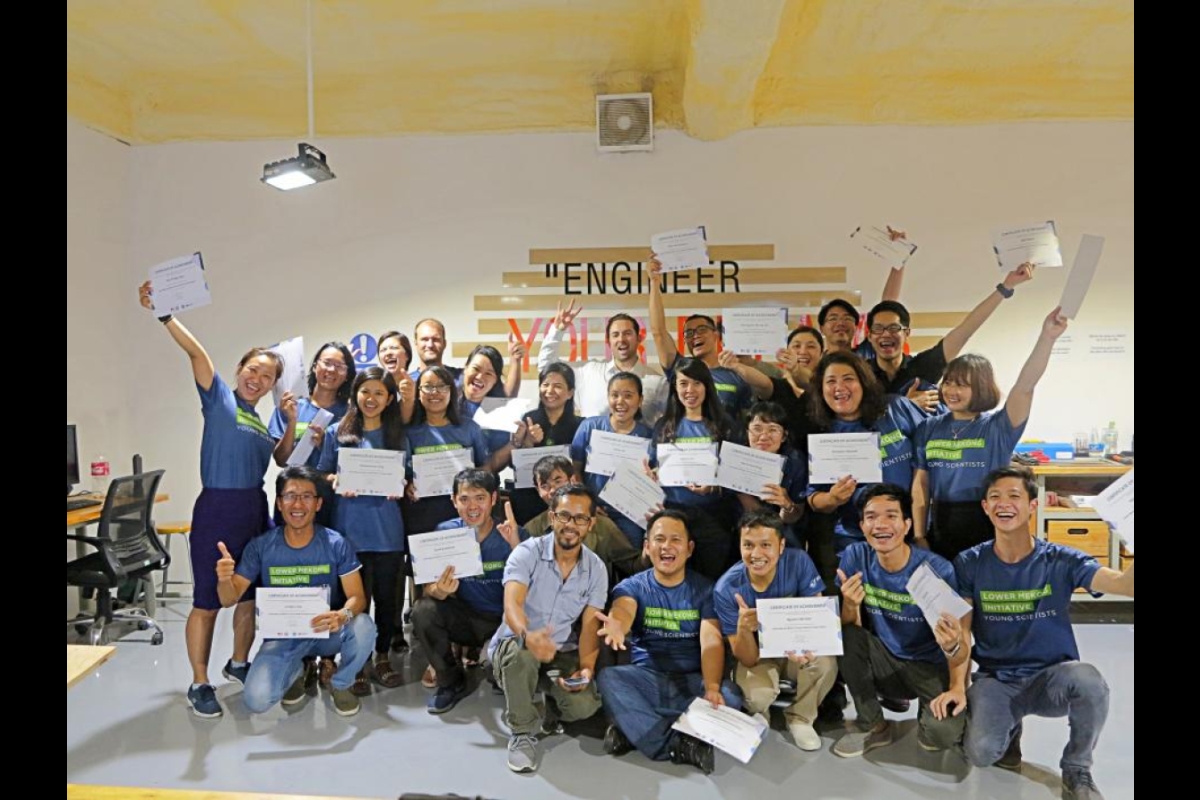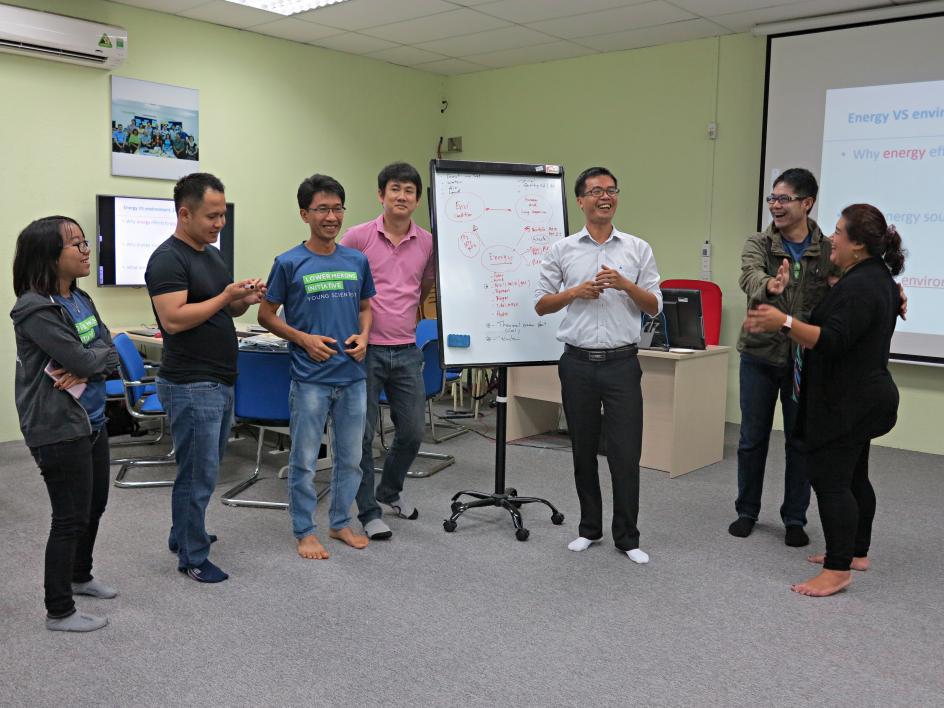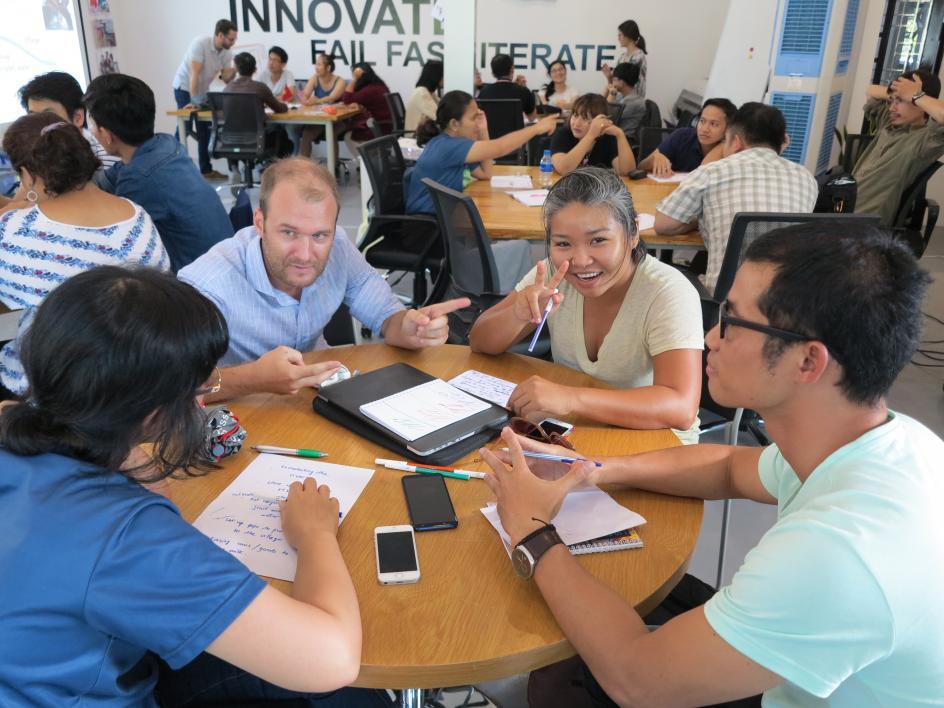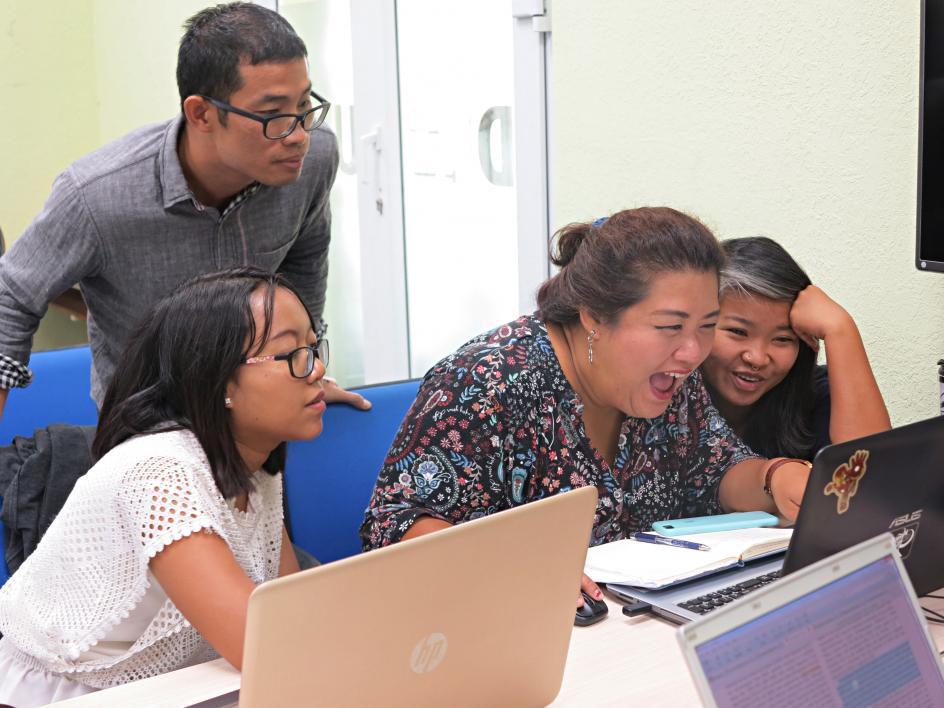ASU creates network of young scientists in Southeast Asia
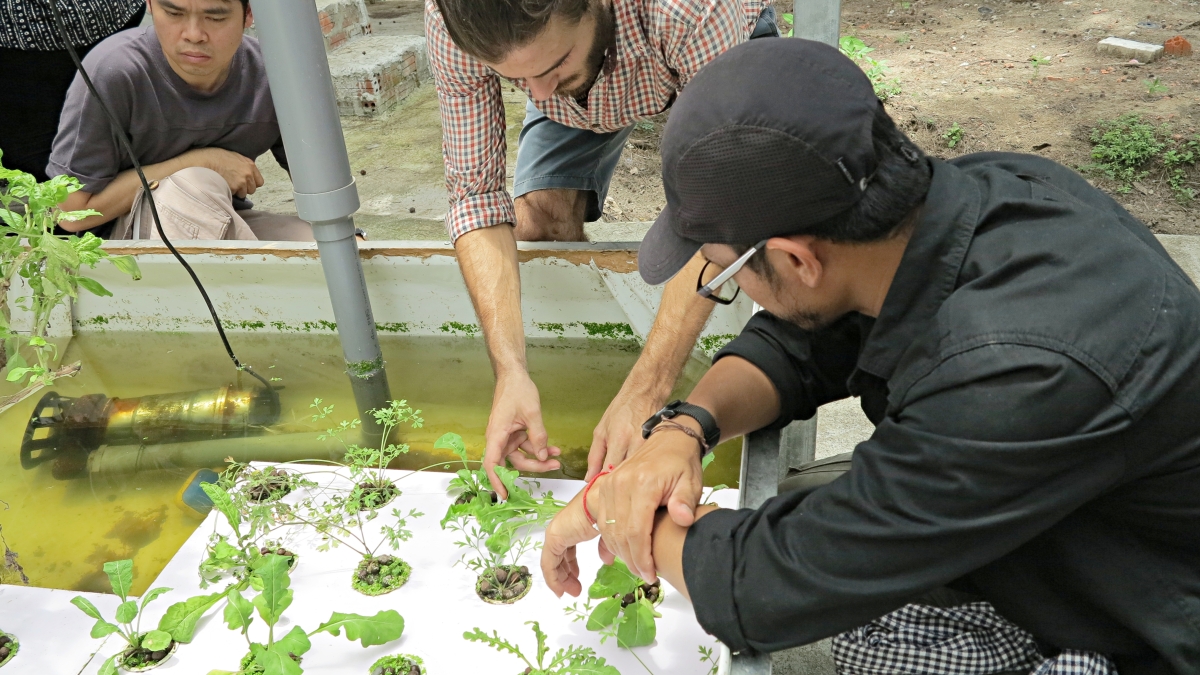
From left: Bundit Buddhahai from Thailand, Gus from France and Phou Bunthann from Cambodia at the Sangha Project aquaponics farm laboratory in Danang, Vietnam. Photo courtesy of Jose Quiroga
Arizona State University is preparing young scientists to improve environmental sustainability, health and economic development through social entrepreneurship.
Last year, the Ira A. Fulton Schools of Engineering partnered with the U.S. Department of State to launch the Lower Mekong Initiative Young Scientist Program. The program’s overarching goal is to create a research community of practice in the five Lower Mekong countries: Cambodia, Laos, Myanmar, Thailand and Vietnam.
Twenty-four young scientists from Lower Mekong countries, who are enrolled in or have recently completed a graduate program in the fields of water, energy or environmental sustainability, participated in the inaugural cohort. They developed capacity for collaborative research through a four-week thematic exchange program, a two-day scientific symposium and a competition for seed funding.
“With 60 percent of its population under 35 years of age, Southeast Asia is one of the fastest growing economic regions,” said Jose Quiroga, director of the Lower Mekong Initiative Young Scientist Program and associate director of the Fulton Schools Global Outreach and Extended Education. “The goal of this program is to support young scientists in developing a network of like-minded professionals who can use science and engineering to find joint, innovative solutions to common challenges in the region.”
The university has decades of experience in sponsored project implementation in Southeast Asia.
Since 2010, the Fulton Schools have partnered with the U.S. Agency for International Development and Intel Corporation to revolutionize engineering and technical vocational universities as part of the Higher Engineering Education Alliance Program. Additionally, the BUILD-IT Alliance has created a world-class model to advance university autonomy and instructional quality.
ASU also played a critical role in the U.S. Department of State’s Young Southeast Asian Leaders Initiative, which builds the leadership capabilities and networking of youth in the region.

Participants in the Lower Mekong Initiative Young Scientist Program had the opportunity to attend the program’s first symposium in Ho Chi Minh City, Vietnam, on Dec. 13–14. Photo courtesy of Jose Quiroga
The Lower Mekong Initiative Young Scientist Program is the latest in the university’s continued successes in strengthening ties between the U.S. and Southeast Asia by creating opportunities for collaboration for early career researchers.
“The program is designed to build a regional community of emerging researchers who acquire technical knowledge by focusing on developing their interpersonal skills through team-based activities, classroom discussions, group presentations and applied research fieldwork,” said Jeffrey Goss, the associate vice provost for Southeast Asia programs in the Fulton Schools.
“Participants are challenged to work across disciplines and regional teams and communicate in English to overcome existing language barriers, as they collaborate to identify technical solutions to Lower Mekong issues.”
Site visits and symposium reveal new perspectives
The researchers kicked off the program with a summer exchange experience hosted at the Ho Chi Minh City University of Technology and Education in Vietnam. The participants attended skill-building workshops and learned how to apply those skills toward research initiatives and technology development to create meaningful impact for the region.
Participants also went on various site visits to further enhance their learning experience. From interacting with locals in Can Tho and the Mekong Delta about irrigation for farming and biogas generation to engaging with two multinational companies about how they’re meeting energy demands in Southeast Asia, participants learned about regional challenges related to water, renewable energy and environmental sustainability.
The exchange program culminated in a trip to Danang, Vietnam, where participants worked on applied projects, developing prototypes for their proposed solutions to transboundary challenges along the Mekong River.
Video courtesy Ira A. Fulton Schools of Engineering
The first cohort of early career researchers had the opportunity to attend and present posters on their applied projects at the program’s first symposium at the Lotte Legend Hotel in Ho Chi Minh City, Vietnam, on Dec. 13–14.
More than 80 researchers and scientists attended the symposium, representing a wide range of participants from academia, industry, government and environmental advocacy groups from the U.S. and Lower Mekong countries. Top researchers with expertise in water, renewable energy and environmental sustainability networked with the program participants and offered feedback on their projects.
“Through the Lower Mekong Initiative Young Scientist Program, we’re building a network of scientists who devise innovative solutions to cross-border environmental challenges faced by the countries of the Mekong region,” said Deputy Consul General Tim Liston, of the U.S. Consulate, Ho Chi Minh City.
The young scientists’ applied projects included an eco-floating farming system for the Tonlé Sap lake in Cambodia, an app for monitoring energy consumption in homes and a play pump water filtration system for schools in rural areas.
“While their solutions to problems were innovative, the main goal of the program was to teach teams the value of working together across disciplines and countries to accomplish a shared goal," Quiroga said.
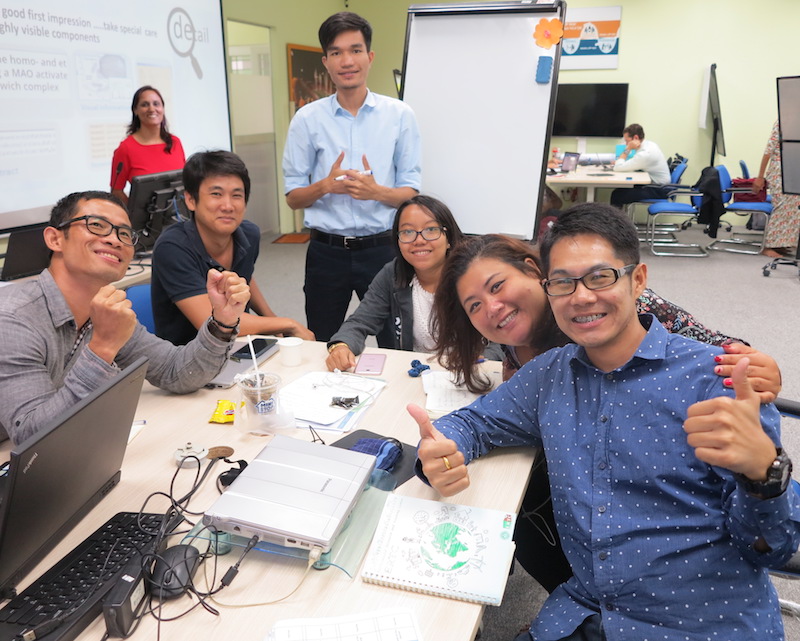 The Lower Mekong Initiative fellows participate in a workshop with John Wiley & Sons on the writing and publishing of scientific papers. From left, Vilay Vannaladsaysy from Laos, Attakarn Jansasithorn from Thailand, Chhunleang Rorm from Cambodia, San Hay Mar Shwe from Myanmar, Jirawadee Polprasert from Thailand and Athit Phetrak
The Lower Mekong Initiative fellows participate in a workshop with John Wiley & Sons on the writing and publishing of scientific papers. From left, Vilay Vannaladsaysy from Laos, Attakarn Jansasithorn from Thailand, Chhunleang Rorm from Cambodia, San Hay Mar Shwe from Myanmar, Jirawadee Polprasert from Thailand and Athit Phetrakfrom Thailand. Photo courtesy of Jose Quiroga
Athit Phetrak, a program participant and lecturer at Mahidol University, benefited from the diverse collaborations with young scientists and researchers across the country. He had the opportunity to work on several projects to improve drinking water quality with the Thailand Research Fund, the Kurita Foundation, the Ministry of Environment of Japan, the Japan Science and Technology Agency and the Tokyo Metropolitan Government Bureau of Waterworks.
“Due to climate change, there is growing concern about water quality after conventional water treatment in the Lower Mekong River basin … However, conventional water treatment is not always effective for high levels of pollutants,” said Phetrak, who received a doctoral degree in environmental engineering at the University of Tokyo, Japan. “Thus, it’s necessary to develop cost-effective water purification technologies to guarantee drinking water safety in these areas.”
Phetrak will continue his studies this year as a visiting researcher at ASU where he’ll work with Regents' Professor Paul Westerhoff on water and wastewater treatment technologies, such as physicochemical treatment processes.
“The results from this study can provide valuable information in the effective removal of organic and fluoride pollutants and thus subsequently control the formation of disinfection by-products in drinking water,” Phetrak said. “Additionally, the outcomes of this study will be of great help to engineers, scientists, researchers and other people who are working in water remediation and materials preparation.”
Opportunities abound for young researchers
Another goal of the program and symposium was to help participants increase their research outputs and submissions to quality, peer-reviewed journals. At the event, the publishing company John Wiley & Sons, a partner of the Lower Mekong Initiative Young Scientist Program, introduced the Wiley Researcher Academy, an online platform designed to deliver training on writing and publishing across the entire global research community.
“We’re really excited to support the Lower Mekong Initiative Young Scientist Program through the introduction of the Wiley Researcher Academy, specifically designed to help early career researchers realize their potential as published authors of high-impact scholarly content,” said Ben Townsend, vice president of global library sales EMEA and APAC at Wiley.
He continued, “the publishing knowledge and expertise Wiley has to offer will now be easily accessed and enjoyed by scientists from across the Lower Mekong region, and ultimately help them improve and disseminate the published results of their scientific research.”
After the symposium, program participants are applying the feedback acquired from top researchers in their fields and submitting project proposals to a review committee for the chance to receive up to $3,000 in seed funding to implement their projects. The committee will select projects based on feasibility, innovation and replicability.
“This program can be considered as a bridge, which connects many young scientists and researchers with a firm connection,” Phetrak said.
More Environment and sustainability

Rethinking Water West conference explores sustainable solutions
How do you secure a future with clean, affordable water for fast-growing populations in places that are contending with unending…
Meet the young students who designed an ocean-cleaning robot
A classroom in the middle of the Sonoran Desert might be the last place you’d expect to find ocean research — but that’s…

From ASU to the Amazon: Student bridges communities with solar canoe project
While Elizabeth Swanson Andi’s peers were lining up to collect their diplomas at the fall 2018 graduation ceremony at Arizona…


